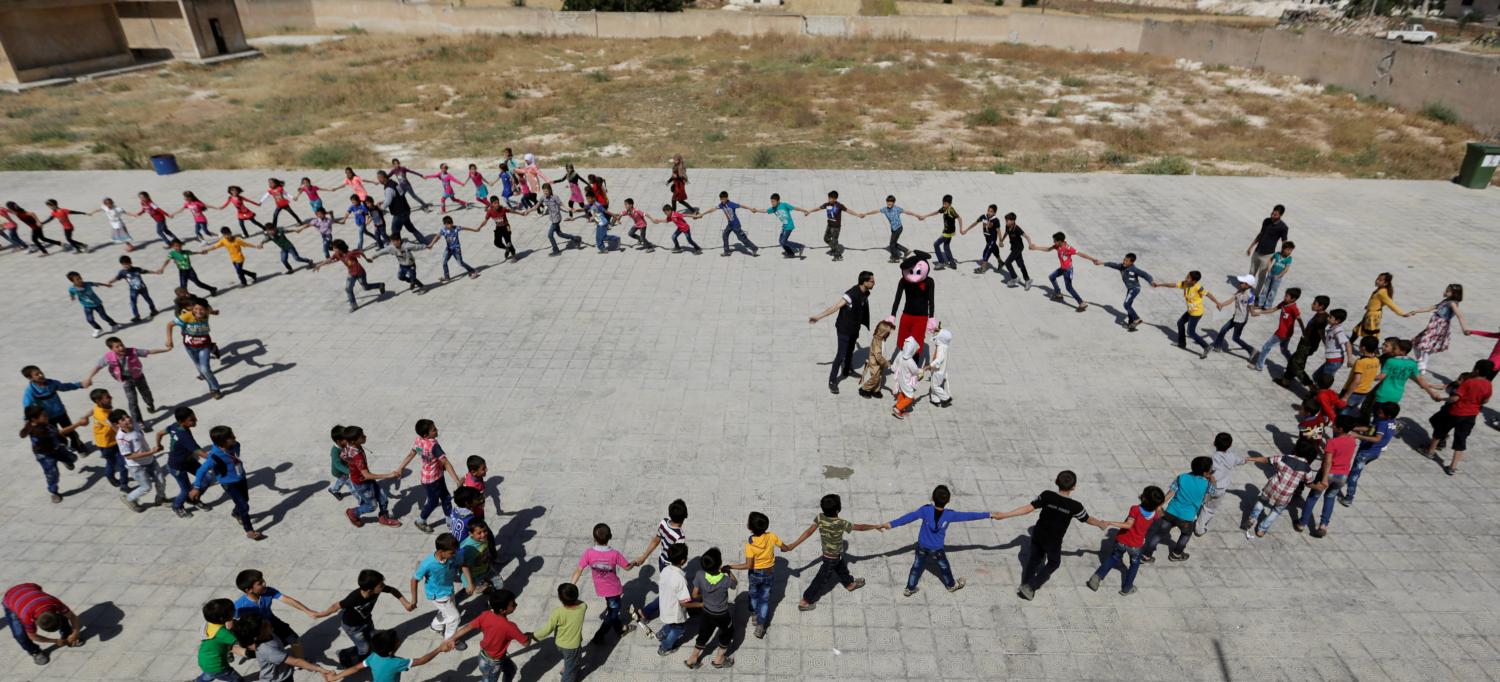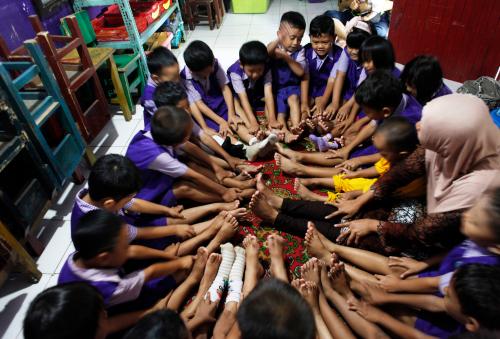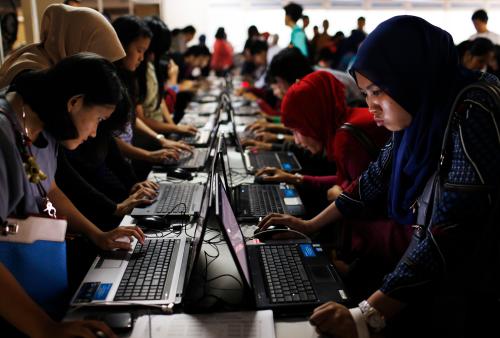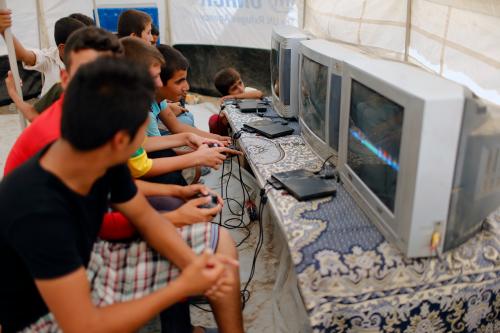This report is an analysis of data found in an interactive map of education policies. Explore the map of a global movement and help us complete this study by sharing any missing information.
A global movement to include a broad range of competencies or “breadth of skills,” beyond literacy and numeracy, is increasingly visible and evident in national education policies and curricula. The breadth of skills movement manifested at an international level within Sustainable Development Goal 41 to ensure inclusive and quality education for all and promote lifelong learning. An outcome of decades of national education reforms, this agreement identifies literacy and numeracy skills, skills for employment and entrepreneurship, and skills needed to promote sustainable development as targets for all children and youth by 2030.
While many countries have adopted a breadth of skills approach in their policies, the degree to which the skills movement is reflected at all levels of education systems varies across countries. Visualizing the breadth of skills movement is one focus of Skills for a Changing World,2 a project at the Center for Universal Education at the Brookings Institution. An initial scan of 102 countries investigates the degree to which breadth of skills is reflected in education systems, from a high level within vision or mission statements to inclusion within curriculums. This scan sought evidence of skills beyond traditional academic skills of literacy and numeracy. From this initial scan, several findings emerged:
• The majority of countries acknowledge the importance of breadth of skills somewhere in their public documents, and many list a number of specific skills or competencies that the education system intends to provide.
• Only a few countries show evidence that these skills are consistently identified in national documents, including mission and vision statements, curriculum frameworks, and descriptions of how skills progress for learners.
• Communication, creativity, critical thinking, and problem solving are the 21st century skills most frequently identified by countries.
These findings show that the skills movement has been underway for some time, at least in national rhetoric. There is less evidence of its articulation in curriculum and pedagogy policies, which may mean it is less evident in classrooms as well. Given probable early stages in implementation, there is clear potential for countries to assist each other in developing approaches to integration of a broad set of competencies within education provision.
To accompany this research on the breadth of skills movement, an online map was created to visualize the degree to which this movement permeates education systems around the world. This visualization is intended to be a resource for policymakers, researchers, donors, and other stakeholders to access information on which countries are incorporating breadth of skills in their education systems.
Explore the interactive »
BACKGROUND
When nations initiate a major curriculum reform, those designing the curricula rely on a synthesis of national objectives and values, historic knowledge, the demands of the economy, and an understanding of the building blocks of learning. In the past, the majority of nations have relied on a content and knowledge approach to teaching and learning, which requires the memorization and recall of facts. There is widespread understanding that education is a progression in learning—simple facts are taught before more complex facts, and the tools to access content and knowledge need to be taught before these complex facts can be accessed. In moving toward breadth of skills, we face a logical extension of this. Now the content and knowledge that we wish to access requires more and different tools to be acquired by learners. And we want to demand more of our learners, that they can work with current knowledge to effect a sustainable future.
Of interest in this study is the degree to which aspirations have already translated into implementation. Although aspirations may be a marker of the future, there are several indicators that can demonstrate how far along a country has proceeded in implementation. Implementation relies on clarity around:
• Whether a country has articulated breadth of skills in its mission or vision for the education system.
• The skills or competencies that might contribute to national aspiration.
• How these skills are embedded in the curriculum.
• How they are presumed to progress as students move through their learning experience.
In our research, we find that many education systems provide mission or vision statements that identify the societies to which the nation aspires. In some cases, countries list the skills individual learners need to fulfill this mission, but in others, this crucial link is missing. For example, some countries aspire to produce global citizens, yet the concept of a global citizen is not well understood. In general terms, it will mean that an individual sees their place in the world as a member of a global community, as opposed to only their village, town, or country. It also implies representation, active involvement in the community, and responsibility. If part of a country’s mission is to produce global citizens, the country must also define what that means. This is where a country needs to identify the particular characteristics and competencies that it values, and ideally, align these with the national vision.
In turn, once a list of such characteristics and competencies is developed, the degree to which these are teachable and learnable needs to be explored. For an education system to value characteristics for which there is no evidence of teachability or learnability may be laudatory, but will fail to produce results.
There is compelling
evidence of a shift in education systems toward
broadening the provision of education beyond traditional
disciplines—beyond a focus on literacy and numeracy alone.
Discussions of approaches to integration of a skills or competencies agenda into curricula identify three main approaches. One approach is to teach the skills as subjects in their own right. Another is to embed the skills in current curricula such that the content of the curricula acts as a vehicle for the development of the skills. The third is to design inter-disciplinary subjects that bring the skills to the fore.
Regardless of the approach envisaged, an essential criterion for inclusion of a skills approach is the appreciation that skills develop. It is insufficient merely to acknowledge that a skill, for example problem solving, is required. Instead, it is essential to clarify that there are different levels of expertise, and that these need to be taught and learned to ensure students will acquire increasing levels of competence within each skill area. Implementation of course requires that the natural progression and acquisition of increasing levels of competence is known.
Accordingly, when exploring how nations plan for implementing skills, or competency-based curricula, four sets of information—the national vision, the competencies that lead to this, how they are embedded in the curriculum, and how they are assumed to progress—are vital to understanding their pathway to the future.
METHOD
National websites were accessed and explored by a team of researchers between May and August 2016. The target was the website of the national education system, and in some cases, the national agency responsible for curriculum development. The team was able to locate relevant information when in English, Spanish, Korean, and French. Beyond this, Google Translate also provided some accessibility, though language constraints limit the information available for the first scan of information that is provided in this report. The team gathered inputs from education sites in 102 countries using four sets of information to identify how the nation includes breadth of skills in their vision and national policies:
1. The mission or vision statements on theeducation websites.
2. Whether specific competencies or skills that related to the mission were identified, either in the mission and vision or in other documents.
3. Evidence of integration of skills in curriculum
documents.
4. Evidence of assumptions about progressing levels of sophistication of skills.
We hypothesize that these sets of information can indicate the degree to which a nation has moved from aspiration to planning for actual education change, to thinking through an approach to integrate competencies in the curriculum, and to initiating a process of delineating growing sets of competencies.
The raw data are excerpts taken from the national websites. The first level of analysis identifies whether these data meet a set of criteria. The results are presented through a visual mapping that can be accessed through skills.brookings-edu-2023.go-vip.net. Official government websites, including their links to publications, as well as websites that indicate collaboration with other agencies (e.g., UNESCO International Bureau of Education) are used. For each set of information, the evidence was coded as either 1) meets criterion, 2) does not meet criterion, or 3) no data found. The visual mapping shows where criteria are met, while the datafile lying behind it provides the actual text excerpts.
The criteria established for the four sets of information are described below:
Mission and vision statements
The education system’s aspiration, as expressed in its mission and vision statements, is clearly linked with the development of a broad range of knowledge and competencies that include 21st century skills and characteristics that are enabling for the individual learner. Meeting the criterion requires identification of individual characteristics or aspiration for the individual rather than a societal aspiration.
Skills identified
Specific skills beyond literacy and numeracy are noted in government documents. Examples of these skills may be collaboration, problem solving, information literacy, creativity, communication, empathy, and so forth. This identification implies that governments value these skills and intend that they are developed through education systems. Explanations of skills are not necessary to meet this criterion.
Skills in the curriculum
A description of the curriculum or the curriculum itself outlines how or where the identified skills will be addressed within basic education provision. This provides evidence that opportunities for embedding skills into education systems have been explored.
Skills progressions
There is some documentation of how specific skills are understood to develop over time and across different education levels. The description of the progression may indicate the understanding that learning is hierarchical and is associated with progression through the curriculum in general.

PRELIMINARY FINDINGS
Across 102 countries, patterns of country information related to skills were analyzed. The focus of the search was for identification of a broad skills agenda beyond traditional academic knowledge. Although countries might aspire for promotion of peace, engagement in lifelong learning, an educated people, or knowledge-based societies, these would not on this basis be identified as having a focus on 21st century competencies or breadth of skills. It could be argued that such aspirations might imply such skills, but in the absence of detail around the development of skills at an individual level, such statements were not identified as meeting the criteria for such recognition.
HOW ARE BREADTH OF SKILLS INCLUDED IN NATIONAL DOCUMENTS?
Overall, information from 102 countries was reviewed (Figure 1). Specific skills are mentioned by 76 countries somewhere in their documents. For example, 36 countries mention skills in their vision or mission statements, and 51 countries mention skills in their curriculum documents. In addition, 11 countries mention progression of these skills across multiple age groups and subjects. These categories are not mutually exclusive. For example, all 11 countries discuss progression of skills in their curriculum guides. In other words, these countries are identified as mentioning “skills” in their “curriculum,” as well as the “progression.” However, there are instances where countries mention specific skills but not in any of the aforementioned categories. For instance, skills are specifically stated in the objectives of basic education (e.g., Afghanistan, Jordan), the national education strategic plan (e.g., Albania, Macedonia), and the country’s national framework for education or education act/plan (e.g., Romania, Sierra Leone).
HOW PERVASIVE ARE BREADTH OF SKILLS WITHIN POLICY DOCUMENTS?
The majority of the countries mention or identify skills in at least one of the four categories (Figure 2). There are six countries that identify skills in all four categories (vision/mission statement, skills identified, skills in curriculum, and skills progression). These countries are Australia, Canada (Ontario), Hong Kong, Mauritius, Scotland, and Singapore. There are 22 countries that identify specific skills in three of the four categories. Some countries such as Brazil, Mexico, Namibia, Rwanda, and South Africa refer to skills progression, although skills are not a feature of their vision/mission statements. There are 31 countries that mention skills in two of the four categories, with the majority of these falling in the curriculum category, and the remainder in their vision/mission statements. Just 22 countries mention skills in only one of the four categories. Most of these countries identify skills in a policy document other than vision/mission statement or curriculum. For example, in their Strategic Plan 2012-20173, Brunei Darussalam commits to building skill sets for capacity development and development of performance mind-set culture by promoting leadership, communication, and teamwork skills. Similarly, Monaco mentions skills when laying out the purpose of primary school as a place where children acquire the basis for future skills and the use of memory, reasoning, and imagination, as well as the respect of rules and the spirit of initiative. Twenty-one countries do not identify skills in any of the four categories.


WHAT SKILLS ARE IDENTIFIED?
The specific skills identified in the policies vary widely from country to country, yet some skills are more common than others (Figure 3). The 21st century skills most frequently identified were communication, which was mentioned in nearly a third of countries, followed by creativity, critical thinking, and problem solving.
CONCLUSION
The information collected to date demonstrates conclusively that national systems of education are broadening their educational provision to equip students with enabling skills beyond literacy and numeracy. The shift is evident across a wide range of nations in terms of their economic development, educational standards, and political stability. It should be noted that countries vary widely in the degree to which they provide detailed information about their systems in the public forum.The data are subject to both false positives and false negatives. What might be inferred from the publically available information might not be evidence-based; what is not presented on the other hand may not reflect what is available in other media. Accordingly, the degree to which this shift represents actual implementation cannot be ascertained from these data.
At a first scan of the information from publically available sources, there is compelling evidence of a shift in education systems toward broadening educational provision beyond traditional disciplines and focus on literacy and numeracy. This confirms findings from prior research on teaching and assessment of 21st century skills4 and transversal competencies,5 which provide a qualitative perspective on the movement with more in-depth information from selected countries.
Over the next year, the Skills for a Changing World project will explore how countries approach implementation in greater detail.








